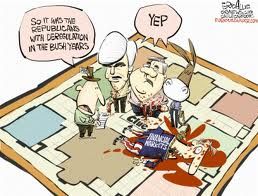Leaders in Congress, particularly John Boehner and Nancy Pelosi are preparing another bipartisan fiasco in order to reward a particularly powerful constituency and stop them from engaging in their annual screamfest.
Every year, due to the structure of Medicare created by previous legislation, doctors and healthcare providers face an adjustment of their pay from the government for services to Medicare recipients. There is a provision in the current Medicare law that creates a “Sustainable Growth Rate” (SGR) for Medicare payments based upon economic growth. Since medical costs have far outpaced economic growth for years, this means that doctors, hospitals and other healthcare providers face a cut in their pay for services to Medicare patients every year.
Because doctors and the healthcare industry have incredibly powerful lobbies working for them, Congress hears their screams loud and clear.
This has resulted in congressional action:
On 17 occasions in the last 12 years, Congress has passed legislation to block such cuts without fundamentally changing the payment formula.
The screaming for Congress to fix this has got Congress’ attention:
Removing the threat of future cuts has been a top goal of lobbyists for the American Medical Association and other doctor groups.
David Dayen has a really good article up on Fiscal Times explaining what Bipartisans Pelosi and Boehner have come up with:
There would reportedly be more means-testing for Medicare beneficiaries, increasing premiums for seniors showing income over $133,000 and couples over $266,000. These seniors would have to pay 65 percent of their total costs under the new plan. This would go up at higher incomes. Means-testing historically dips lower and lower as budgeters try to get more out of beneficiaries, so this continues that ratcheting process for Medicare. It’s not necessarily where this line is set now but where it might go in the future that should cause concern.
Under the deal, new Medigap policies – privately sold but publicly managed plans which fill in spaces in Medicare coverage – would need a $250 deductible starting in 2020. Virtually every senior I’ve ever spoken with says that they need supplementary coverage because Medicare doesn’t stretch far enough. But this would raise out-of-pocket expenses on all 9 million seniors with a Medigap plan, including the 86 percent of these beneficiaries who have incomes under $40,000, and almost half with incomes below $20,000. So this cut hits those who can’t really afford it. (This idea, along with the means-testing, was in President Obama’s budget, incidentally.)
See who gets to pay the bill for this?
The proper term for this is cost-shifting, pushing funding for a public program onto those who get the benefits. Medigap was created to deal with cost-shifting in Medicare, and now Congress may look to shift costs within it as well. And like means-testing, cost-shifting is prime terrain for double-dipping over time.
And look at who doesn’t have to take a haircut:
All of this is being done to protect doctor salaries, which are among the highest in the industrialized world.
Dayen links to this article in the New England Journal of Medicine that shows the majority of healthcare spending goes to salaries:
Of the $2.6 trillion spent in 2010 on health care in the United States, 56% consisted of wages for health care workers. Labor is by far the largest category of expense: health care, as it is designed and delivered today, is very labor-intensive. The 16.4 million U.S. health care employees represented 11.8% of the total employed labor force in 2010. Yet unlike virtually all other sectors of the U.S. economy, health care has experienced no gains over the past 20 years in labor productivity, defined as output per worker (in health care, the “output” is the volume of activity – including all encounters, tests, treatments, and surgeries – per unit of cost). Although it is possible that some gains in quality have been achieved that are not reflected in productivity gains, it’s striking that health care is not experiencing anything near the gains achieved in other sectors. At the same time, health care labor is becoming more expensive more quickly than other types of labor. Even through the recession, when wages fell in other sectors, health care wages grew at a compounded annual rate of 3.4% from 2005 to 2010.
Those doctors must have a really effective union representing them!
Dayen also points out one other less obvious way that the bipartisans will be robbing patients to reward the screaming healthcare industry:
Doctor payment rates are tied to Medicare premiums, as the Congressional Budget Office has explained: “Beneficiaries enrolled in Part B of Medicare pay premiums that offset about 25 percent of the costs of those benefits.” This means that any permanent change to a new doctor payment formula will likely result in a hike to Part B premiums.
Those folks that aren’t represented by powerful lobbies apparently have a couple of days to scream at their “representatives” to stop this monstrosity that will likely cause people with lesser incomes to forego needed medical care. The bipartisans are feeling good about their prospects for getting the doctors off their backs and sticking us with the bill:
House of Representatives Speaker John Boehner said on Tuesday that prospects were good for passage of a permanent fix to Medicare’s flawed doctor-pay formula that would spare physicians from impending steep pay cuts. …
Earlier on Tuesday, Boehner and House Democratic Leader Nancy Pelosi announced that bipartisan legislation had been introduced to change the way doctors are reimbursed for Medicare costs. A vote is expected on Thursday.
Thursday. Hey, that’s not too far away!
Better call your congressperson and share the Secret Word with them. The secret word is “Medicare.”
You know what to do when somebody (even you) says the secret word – scream real loud!

 Writing for
Writing for
Recent Comments